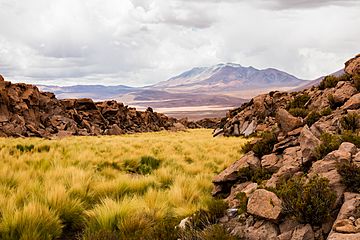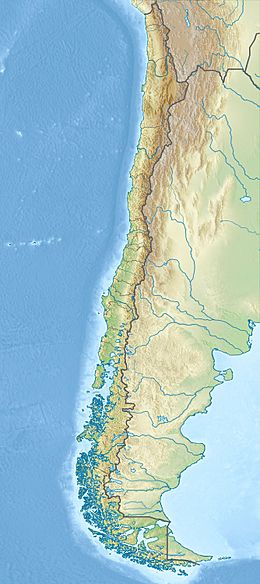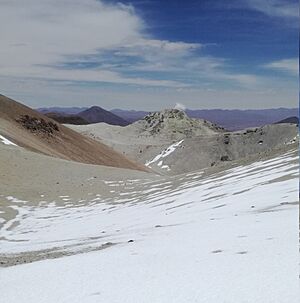Olca facts for kids
Quick facts for kids Olca |
|
|---|---|
 |
|
| Highest point | |
| Elevation | 5,407 m (17,740 ft) |
| Geography | |
| Parent range | Andes |
| Geology | |
| Mountain type | Stratovolcano |
| Last eruption | 1867 |
Olca is a large stratovolcano located right on the border between Chile and Bolivia. It sits in the middle of a long ridge, which is about 15 kilometers (9 miles) long. This ridge is home to several other volcanoes. For example, Cerro Minchincha is to its west, and Paruma is to its east.
Olca is made up of volcanic rocks called andesite and dacite. Its lava flows have spread out for several kilometers north of its peak. The only known eruption from this volcanic ridge happened between 1865 and 1867. Scientists are not entirely sure where on the ridge this eruption came from.
Volcano Gases and Hot Springs
Olca volcano constantly releases gases and steam. You can find a warm spring at the bottom of the volcano. There is also a special area called a fumarole field near the crater's dome. This field has been active for at least 60 years.
A fumarole field is an area where gases and steam escape from the ground. The one at Olca is about 0.1 square kilometers (0.04 square miles) in size. Scientists study these gases to learn more about what is happening deep inside the volcano. They have found that the gases come from a mix of very hot volcanic gases and water from underground.
Scientists use special tools to measure the amount of sulfur dioxide (SO2) gas coming out. This helps them understand how active the volcano is. Recent measurements show that Olca releases a good amount of this gas every day.
Volcano's Past and Recent Activity
Scientists have different ideas about when Olca volcano first formed. Some studies suggest it formed during the Pleistocene Ice Age. Other ideas point to it being much older. It seems that the volcano's activity moved eastward over a long time. There is also proof that glaciers were present on Olca during the late Pleistocene period.
There are reports of possible eruptions between 1865 and 1867. However, these events are not fully confirmed. More recently, there have been signs of activity. In November 1989 and March 1990, scientists noted small earthquakes and strong gas releases.
In 2010, another study looked for seismic activity. They found three possible groups of small earthquakes. However, it was not clear what these signals meant for the volcano's activity.
See also
- Ollagüe
- List of volcanoes in Bolivia
- List of volcanoes in Chile
 In Spanish: Volcán Olca para niños
In Spanish: Volcán Olca para niños



